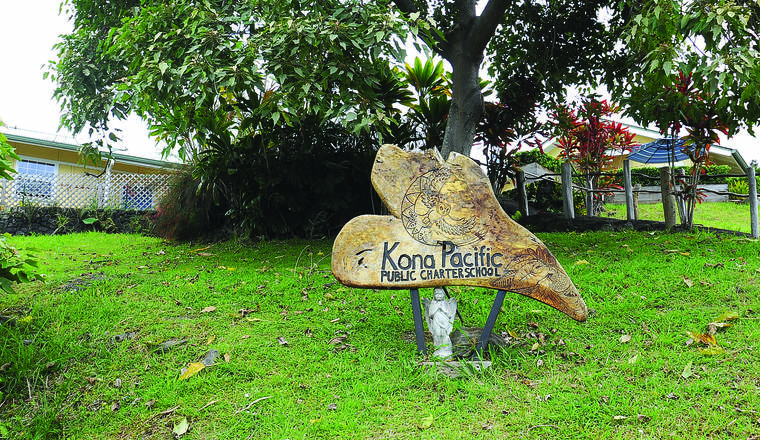KEALAKEKUA — Kona Pacific Public Charter School is on a mission.
The school, loaded with new board members, is looking for more students and more money from the community in order to survive this school year, and into the future.
“Is this school going to make it through the year?” president Zachary Hosler asked. “I don’t know. I can’t tell you 100% yes.”
Hosler and Kona Pacific’s new pedagogical director Greg Learned addressed a crowd of concerned parents and teachers at a town hall meeting Wednesday evening at the school. The meeting centered on the charter school’s most pressing issue — keeping the school afloat.
“When I was asked to return to this school in this position, I knew that I was taking on a pretty challenging role,” said Learned, who was previously a teacher at the facility. “We are in a budget crisis as a school.”
Kona Pacific is a Title I charter school, meaning the poverty threshold is a minimum of 47.2%. Poverty is determined by family enrollment in two federal programs — Community Eligibility Provision and the Free and Reduced Lunch Program — during the prior school year. The school is currently entering its third year of the Department of Education’s Continuous School Improvement (CSI) program.
The school, established in 2008, has been in the center of a controversy of late.
In May, all of the previous Kona Pacific Public Charter School board members announced their resignation.
The resignations saved the school from closure this year, as the state Public Charter School Commission accepted the resignation as an alternative to revoking the school’s charter contract, a move the commission initiated in March.
Allegations made against the school by the commission included claims that the school commingled funds with the nonprofit that owns the land, overpaid lease rent and that the nonprofit was driving the governing board’s financial decisions.
“In 2016 and 2017, our school hit a very low point,” Learned said. “That year, our testing scores tanked, our chronic absenteeism sky-rocketed, and we triggered something within the state Department of Education that said the school needs to change, and it needs it right now.”
As a CSI school, Kona Pacific has a three-year window of receiving more funding from the government for new programs, more materials and supplies, more training for teachers and a better curriculum.
“Testing scores have gone up significantly, chronic absenteeism has gone down, so we’re actually meeting our requirements right now with our CSI under Title I. We’re actually in a good place,” Learned said. “But we’re entering our third year. This influx of funds that have come in and supported the school the last two years … this all comes to a close at the end of the year.”
If the school survives to see the 2020-21 school year, it will be out the $300,000 it receives from the CSI program.
“We, as a school, have to really adapt ourselves and figure out how do we reorganize things, how do we make ourselves a little more leaner, how do we make ourselves more efficient in the way that we are able to move forward,” Learned said.
Learned said one of the easiest ways for Kona Pacific to meet its financial needs is to increase enrollment, which is also an obstacle the school must overcome this year.
As of this week, Kona Pacific, which serves students from kindergarten through eighth grade, has 205 students. By Oct. 15, the school needs 220 students.
“We get almost $8,000 per student to create a budget, so the school has to live within this budget that we created. And when we start the year, the board has to look at the budget and say we believe we’re going to have this many students that we’re going to be paid for,” Learned said. “We get that amount of money for every student that is enrolled as of Oct. 15. They will take a snapshot of our enrollment on that day, and they will say this is how many students you have for the rest of the year, and this is the amount of money you’ll get.”
Learned said 220 students will bring in the amount of money that Kona Pacific can survive on for the rest of the school year.
The school’s kindergarten, seventh and eighth grades are the classrooms that are most in need of new students. Learned said it’s unusual for the school to see low enrollment in the kindergarten class.
Learned stressed to the parents in attendance at Wednesday’s meeting the importance of fundraising activities, which help bring in more money from the community to the school.
The parents that attended the meeting vocalized their dissatisfaction with the way communication has been handled in the past between the board, the parents, and the faculty and staff. They expressed the need for transparency from the board members on the problems the school is facing and what can be done to help fix those problems.
“Instead of just telling us the problems, why not propose a solution too, so we can help,” one parent proposed.
Learned said the school is hoping to hire an executive director in the near future, a job that would act similar to the job of a principal in a non-charter school.
“I know that in our community, there’s been a lot of talk about Kona Pacific, and there’s been a lot of people who have left unhappy with the school. There’s been a lot of drama related to it,” Learned said. “And we know that we have people that are watching us, who would like to see us succeed, but they’re watching to see how we pull this off.”




